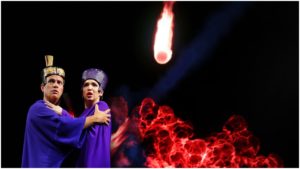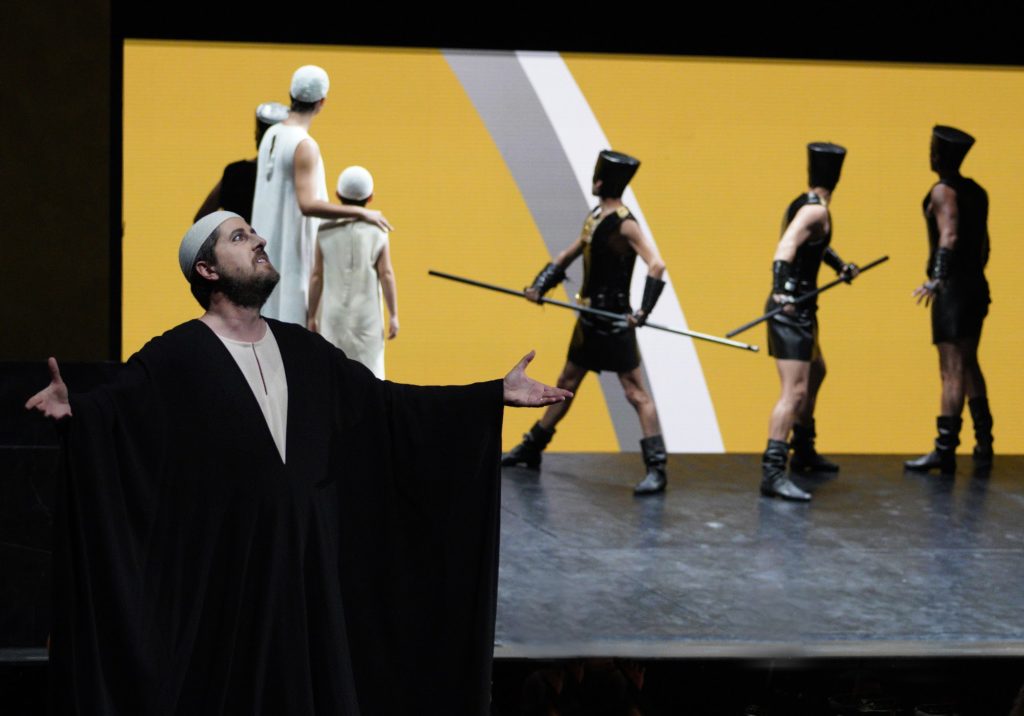
Rossini Opera Festival 2021 Review: Moïse et Pharaon
Rossini Rarity Given A Compelling If Flawed Performance
By Alan Neilson(Photo: Amati Bacciadi)
Rossini’s opera “Moïse et Pharaon” was premiered at the Paris Opera in 1827. Although it is based on his opera “Mosè in Egitto,” written for Naples’ Teatro di San Carlo in 1818, it is largely a new work with significant differences. The libretto, rewritten by Luigi Balocchi and Etienne de Jouy, altered the dramatic structure, for which Rossini included three completely new numbers, significantly modified others, increased the role of the chorus, introduced an extensive ballet scene, expanded the orchestra, and incorporated spectacular visual elements, in order to bring it into line with French tastes. The number of acts was increased from three to four, and several characters were also renamed. Today it is rarely performed, so the Rossini Opera Festival’s decision to open this year’s edition with a new production under the musical direction of Giacomo Sagripanti and the stage direction of 91-year-old Pier Luigi Pizzi is a welcome one indeed.
Aesthetic Inconsistency
Pizzi also took it upon himself to act as set and costume designer and thereby became responsible for the entire staging. The results of which were excellent and disappointing in equal measure, with the lack of a consistent aesthetic being its biggest drawback. On the one hand, Pizzi opted for a series of fairly static tableaux, with minimal scenery in which the supernumeraries took up stylized poses, against a single, block-colored backdrop. Some were very effective, others less so. While he made use of computer imagery and film often to good effect, it had little artistic connection, not just to the static scenes, but often to each other. So when Moïse creates a rainbow in the sky, we were presented with a simple white arc, which looked more like a concrete bridge, against a yellow background; a disappointing effort, which grabbed attention more for its lack of imagination than anything else. Meanwhile, the eruption of the volcano which brings Act one to a close was brilliantly executed with meteors showering down onto the Egyptian guards and setting fire to the Earth.
The disconnect was carried over into the costuming, although to a much lesser extent. The Hebrews were dressed in traditional clothes of the period, generally in drab colors of brown and white, with the Egyptian Pharaoh and his family dressed in purple, dark blue, and gold with suitable headwear. The two opposing camps were neatly defined and contrasted well. However, the Egyptian guards were dressed in tight-fitting black leather tops, with short black leather skirts and black leather helmets, and while this enhanced the stylized design of the static tableaux, and aesthetically complemented the colorful clothing of Pharaon and his family, they jarred with the Hebrews traditional clothing.
Before the beginning of the performance, one could not help but wonder how Pizzi was going to present the work’s many fabulous scenic spectacles, particularly the final act in which Moïse parts the Red Sea. The Act opened with the Hebrews crowded on the stage with a gray sea projected onto the backdrop behind them, giving the impression that they were standing on its shore. As the Egyptians approached Moïse, with his back to the audience, arms outstretched walked towards the water, and it parted. The Hebrews then followed him down below the stage. As the Egyptians arrived, the waters raged up and swallowed them in what was an excellently managed and thrillingly presented scene.
As the opera was presented without cuts, it meant that the entire Act three ballet scene was performed. Although it was imaginatively choreographed by Gheorghe Inacu and expertly performed by primi ballerini Maria Celeste Losa and Giacchino Starace, its effect was not a positive one, and severely disrupted the flow of the drama. Even a bold attempt to integrate it into the narrative failed to convince.
Two Powerful Basses Meet Head On
Rossini decided on basses for both of the titular roles. Unusual, but not surprising given both character’s positions of political and religious authority within their societies: Moïse the patriarch of the Hebrews and Pharaon the ruler of the Egyptians.
In the role of Moïse was Roberto Tagliavini, who produced a strong, dominating portrait of the Hebrew leader. His well-supported, confident, and clear-toned voice, along with his physical stature and commanding presence oozed authority. Nowhere was this better illustrated than in Act four, scene three, in which he calls upon God to save his people in the prayer “Des cieux où tu résides,” followed by the recitative “Au sein des flora soumis.” Tagliavini’s identification with the role was total, the strength of conviction that he brought to his singing was compelling. He was an incarnation of a leader and such was the certainty of his actions and of their results; it was unthinkable that the Hebrews would not follow him into the dividing waters.
The role of Pharaon fell to the Uruguayan bass Erwin Schrott. His ability to turn up the volume at will almost ensures that he will dominate and any challenger would struggle to compete. Such is the strength of his voice that it actually escaped the confines of the theatre constructed within the sports arena, and could be heard echoing around the building. His clashes with Moïse were real heavyweight affairs, yet their strengths were very different and reflected their characters. While Tagliavini possessed the more nuanced voice along with the inner strength that springs from religious certainly, Schrott was the more virile and powerful. That was underscored by the real political power which could be enforced through violence, which was perfectly illustrated in their first encounter towards the end of Act one in which a defiant Moïse and an angry Pharaon faced each other. Standing on a platform that ran along the front of the orchestra they engaged each other in what was a battle royal.

(Credit: Amati Bacciardi)
Two Strong Female Performances
Soprano Eleonora Buratto played the role of Moïse’s niece Anaï, who is forced to choose between her love for the Pharaon’s son Aménophis and her people and religion. Buratto possesses a strong, agile voice with an appealing upper register. It is also very expressive, which she used intelligently to fill out the emotional depth of the character, which she wonderfully illustrated in her final act aria “Quelle horrible destinée!” in which she laments her conflicted position. Inflecting the voice with well-positioned accents and emotional emphasis, her rendition brought out the depth of her suffering for which there was no solution. She tackled the leaps and coloratura with apparent ease, with her voice moving easily through the registers. In ensemble numbers she was equally effective, her voice complementing and contrasting beautifully with the other singers.
Mezzo-soprano Vasilisa Berzhanskaya was parted as Pharaon’s wife, Sinaïde. Although not a particularly important role, she is provided with the aria “Ah, d’une tendre mère,” one, which if delivered well, is certain to wow the audience, and she did not disappoint! After the cantabile in which she implores Aménophis to renounce his love for Anaï and a brief passage of recitative in which she is convinced to relent, she moved into the cabaletta in which she looks forward to the marriage and the feast of Isis. Against a strong, brisk orchestral accompaniment, Aménophis, and a large chorus, Berzhanskaya produced a bravura performance. Singing with passion and agility she embarked on a florid coloratura display, which culminated in her voice pushing strongly upwards, and easily rose above the combined musical forces. The audience rightly thundered out prolonged applause for what was a dazzling vocal display.
Moïses’ brother Éliézer is for the most part a background figure, but the performance by tenor Alexey Tatarintsev in the role captured the attention with a refined singing performance, in which his elegant phrasing and pleasing even-toned timbre impressed.
It was not a particularly successful evening for Andrew Owens in the role of Aménophis. He seemed uneasy in the role and struggled to impose himself, especially in the ensemble pieces, in which he could not match the vocal strength of the main soloists. His duet with Buratto in Act one “Ah, si je perds l’obiet que j’aime” was notably imbalanced. Although, the final duet “Jour funeste, loi cruelle,” again with Buratto, did show significant improvement.
Monica Bacelli as Anaï’s mother Marie produced a very neatly defined performance. Her voice may be thinning slightly, but her ability to imbue it with meaning and emotional depth remains strong. That enabled her to produce a convincing rendition of her part in the Act one duet with Buratto, in which their voices combined sympathetically with each other, and on an equal footing
Bass Nicolò Donini was cast in the two small roles of Osiride, the High Priest, and the Voix Mystérieuse, in which his voice was amplified to give it an otherworldly quality. He produced solid performances in both parts.
Tenor Matteo Roma acquitted himself well in the small role of Aufide.
One of the features of the opera is its splendid ensembles, in which the finale to Act three stood out. All nine soloists participated, which they performed with real energy and drive, but it was the added sense of competition between Moïse and Pharaon, and between Anaï and Sanaïde which elevated it to a higher level.
The Coro del Teatro Ventidio Basso under the direction of Giovanni Farina was in excellent voice, although certainly under a tight reign from Sagripanti. For most of the performance, they were situated on a raised area on each of the orchestra, which created a nicely balanced sound, depending, of course, upon where one was sitting, and freed up the space on the stage for Pizzi’s minimalist staged tableaux.
Sagripanti’s Precise and Detailed Reading
Sagripanti’s musical direction displayed a high degree of precision and detail, which allowed for the individual contributions from sections of the Orchestra Sinfonica Nazionale Della RAI to be clearly audible, and the rich textures of Rossini’s score to be revealed. He was particularly attentive to maintaining the musical balance and spent large parts of the performance with his fingers pressed to his lips, quietening the chorus or a section of the orchestra which was becoming too prominent. Occasionally, his control bordered on the excessive, with the orchestra reduced to barely a whisper, although this certainly enhanced the dynamic contrasts and added to the dramatic tension. However, he was less demanding of the soloists, who appeared to be given a freer reign, which led to certain imbalances, in which the tenors, in particular, were occasionally overwhelmed by the formidable power of Schrott, Buratto, and Tagliavini’s voices. Overall, however, it was an impressive performance from Sagripanti, who assuredly held together the large orchestra, chorus, and nine soloists, producing a dramatically strong performance.
Despite certain flaws, this was a highly entertaining presentation that delighted on so many levels. Certainly, everything will improve through the run of performances, yet everything succeeded. Such is the scope and size of “Moïse st Pharaon,” it would certainly benefit from more frequent productions, such is its potential for interpretation, both dramatically and musically.



